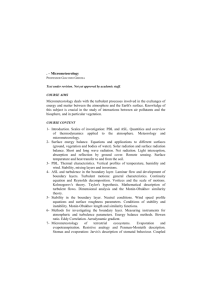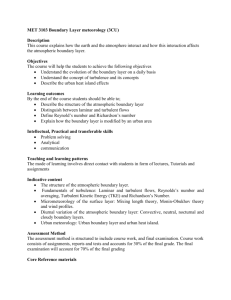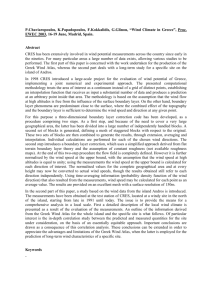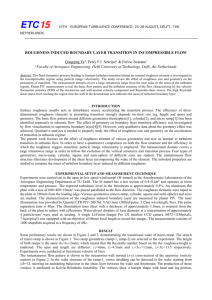1.5 Surface Layer Theory
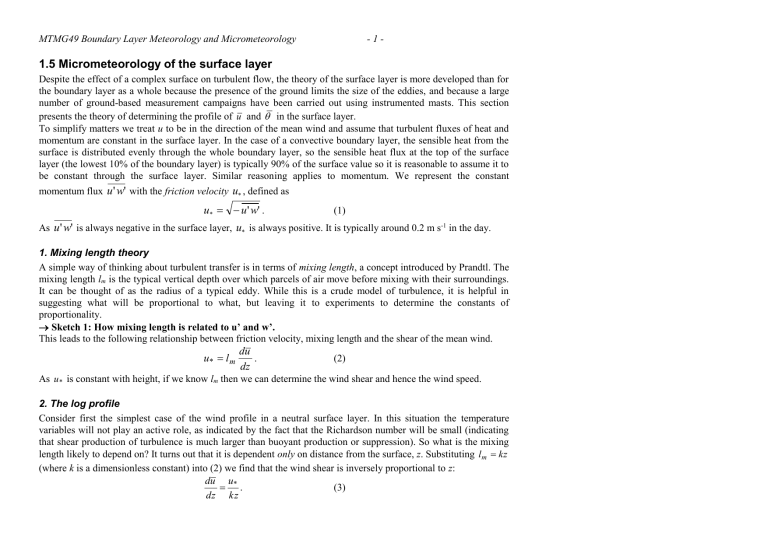
MTMG49 Boundary Layer Meteorology and Micrometeorology - 1 -
1.5 Micrometeorology of the surface layer
Despite the effect of a complex surface on turbulent flow, the theory of the surface layer is more developed than for the boundary layer as a whole because the presence of the ground limits the size of the eddies, and because a large number of ground-based measurement campaigns have been carried out using instrumented masts. This section presents the theory of determining the profile of u
and in the surface layer.
To simplify matters we treat u to be in the direction of the mean wind and assume that turbulent fluxes of heat and momentum are constant in the surface layer. In the case of a convective boundary layer, the sensible heat from the surface is distributed evenly through the whole boundary layer, so the sensible heat flux at the top of the surface layer (the lowest 10% of the boundary layer) is typically 90% of the surface value so it is reasonable to assume it to be constant through the surface layer. Similar reasoning applies to momentum. We represent the constant momentum flux u ' w ' with the friction velocity u
*
, defined as u
*
u ' w ' . (1)
As u ' w ' is always negative in the surface layer, u
*
is always positive. It is typically around 0.2 m s
-1
in the day.
1. Mixing length theory
A simple way of thinking about turbulent transfer is in terms of mixing length , a concept introduced by Prandtl. The mixing length l m
is the typical vertical depth over which parcels of air move before mixing with their surroundings.
It can be thought of as the radius of a typical eddy. While this is a crude model of turbulence, it is helpful in suggesting what will be proportional to what, but leaving it to experiments to determine the constants of proportionality.
Sketch 1: How mixing length is related to u’ and w’.
This leads to the following relationship between friction velocity, mixing length and the shear of the mean wind.
As u
* u
*
l m d u
. (2) dz
is constant with height, if we know l m
then we can determine the wind shear and hence the wind speed.
2. The log profile
Consider first the simplest case of the wind profile in a neutral surface layer. In this situation the temperature variables will not play an active role, as indicated by the fact that the Richardson number will be small (indicating that shear production of turbulence is much larger than buoyant production or suppression). So what is the mixing length likely to depend on? It turns out that it is dependent only on distance from the surface, z . Substituting l m
kz
(where k is a dimensionless constant) into (2) we find that the wind shear is inversely proportional to z : d u dz
u
* k z
.
(3)
MTMG49 Boundary Layer Meteorology and Micrometeorology - 2 -
We know that wind speed must fall to zero at some height we will call z
0
. Integrating this expression: u
d u
0
u k
* z
z
0 dz z yields the log wind profile: u
u
* k ln
z z
0
(4)
As you will find in experiment 1, this is an excellent model for the wind profile near the ground in almost all conditions. In this equation
k is von Karman’s constant and has a value, derived from observations, of around 0.4. Amazingly it is the same for all turbulent fluids. Note that it is sometimes written as (the Greek letter “kappa”).
z
0
is the fact z
0 roughness length , defined as the height where the wind according to the log law falls to zero. In
lies within the roughness sub-layer where u
deviates from the log law. It represents the bulk effects of roughness elements in the surface layer and very approximately has a value around 0.1 times the height of the roughness elements.
3. Monin-Obukhov scaling of the surface layer
Most surface layers are either stable or unstable. The effect of buoyancy is to increase turbulence and hence to change the diffusivity for a particular value of momentum flux and height. Conceptually it is easiest to think of this as changing the typical size of the eddies, as illustrated in Fig. 1 (don’t worry about the meaning of L for the moment). We modify our definition of the mixing length to reflect this: l m
kz /
m
, (5) where m
is a dimensionless parameter related to stability.
In the absence of a physical theory of turbulence, Monin and Obukhov (1954) used dimensional analysis to help determine m
. In this procedure one lists the variables that one thinks the solution will depend on, and combines them in such a way (using multiplication, division etc.) that the combination has the correct units. In our case we want to know the value of the dimensionless parameter m
.
Figure 1. Schematic indicating the typical size of the eddies that are responsible for the mixing as a function of height and
Obukhov length L, for neutral, stable and unstable conditions. The Businger-Dyer relations were used, and eddies drawn with a radius equal to the mixing length l m
.
MTMG49 Boundary Layer Meteorology and Micrometeorology - 3 -
What are the parameters that m
is likely to depend on?
The only dimensionless form is z / L
, where is referred to as the Monin-Obukhov stability parameter , and the Obukhov length is defined as
Obukhov length L =
Note that it is a function of surface variables only . m
is a function of z / L only . This function must be determined by experiment but should be universally applicable. Substitution of (5) into (2) yields d u dz
u
* kz
m
z
L
. (6)
4. Physical interpretation of the Monin-Obukhov stability parameter
We can interpret z / L
physically. In the turbulent kinetic energy equation we have
Buoyancy production term
g w
g H
C p
.
So the grouping of w
and g /
is no accident: this term directly affects turbulence. Also in the TKE equation:
Shear production term
u
w
u z
u
*
2
u z
and in a neutral surface layer this term equals u
*
3 k z
.
Hence
z / L
buoyancy suppression shear production in equivalent neutral conditions .
From this definition it is no surprise that z / L conditions (i.e. when
R i
0
), it turns out that
is uniquely related to gradient Richardson number, and in unstable
R i
z / L
. | L | is the height above the ground where the buoyancy and shear production of TKE are of equal magnitude; below this height shear dominates and above it buoyancy dominates.
MTMG49 Boundary Layer Meteorology and Micrometeorology - 4 -
Interpretation of the value of z/L :
5. The Monin-Obukhov functions
From experiments in very homogeneous conditions, the following Businger-Dyer relationships have been found between m
and z / L
(Dyer 1974, Garratt 1992):
Stable conditions ( z / L
Unstable conditions ( z
0
/ L
):
0
):
h h
m
2 m
1
1
5 z
L
16 z
L
Note that we should generally restrict the application of these relationships to
1 / z
2
| L |
.
(7)
(8)
There are also some useful relationships with gradient (or bulk) Richardson Number, which is easier to measure than L because it depends only on gradients of mean quantities:
Stable conditions ( z / L
0 ; 0
R i
0 .
2 ): z / L
Unstable conditions ( z / L
0
;
R i
0
):
Revision tip: You don’t need to memorise (7)-(10).
z / L
1
R i
R i
5 R i
(9)
(10)
Figure 2. Observations of m
versus the Monin-Obukhov stability parameter z / L
by Businger et al. (1971, J.
Atmos. Sci., 28, 181-189).
MTMG49 Boundary Layer Meteorology and Micrometeorology - 5 -
From m
we can calculate u
:
Sketch 1: How surface buoyancy affects the wind profile.
Figure 3. Observations of the
Monin-Obukhov stability parameter versus gradient Richardson number from Businger et al. (1971)
6. The temperature profile in non-neutral conditions
So far the discussion has been with regard to turbulent momentum transport, but for other parameters, particular heat, we use the dimensionless parameter h
, which turns out to be equal to m
in stable conditions but equal to
2 m
in unstable conditions. Defining a turbulent temperature scale expression as (8) but for temperature: d
dz
* kz
h
z
L
.
*
(11) w
/ u
*
, we can write an analogous
For stable conditions we have
0
* k
ln z z
T
5 z
L z
T
, (12) where
0
is the surface temperature and aerodynamic roughness length z
0
. z
T
is the roughness length for temperature, and is usually less than the
MTMG49 Boundary Layer Meteorology and Micrometeorology - 6 -
7. Parameterising K in numerical models (non-examinable)
How does this relate to K theory, and how mixing is represented in numerical models? Recall that the eddy diffusivity for momentum is defined such that u ' w '
l
2 m
K m u
u z
. (13)
Substituting in (1) and (2) leads to
1 )
K m
z
(14)
In the surface layer, use of (2) and (5) enables this to be expressed as
K m
u
* l m
u
* kz /
m
Hence in neutral conditions (
m
(15)
the eddy diffusivity is proportional to distance above the surface. In numerical models we need to blend smoothly between the surface layer and the rest of the boundary layer. In the Met Office model, the mixing length in (14) is split into a neutral mixing length
K m
2 m f m
( R i
)
u z
m and a stability function
(16) f m
( R i
) :
The neutral mixing length can be formulated to vary smoothly between kz in the surface layer and a constant value in the rest of the boundary layer above:
Typically
1
m
1 kz
1
0
. (17)
0
is constant at around 50 m, or is some fraction of the boundary layer depth. A number of formulations for f m
( R i
) have been suggested, but one that arises naturally in stable conditions by combining (7) and (9) results in (16) becoming
This would be valid for 0
R i
0 .
2
K m
2 m
1
and above 0.2,
5 R i
2
u
(18) z
K m
would be set to zero (no mixing).
K theory works well in near-neutral and stable situations, but in convective boundary layers, u and are wellmixed, i.e. constant with height. From (14), zero gradient implies zero turbulent flux, but the heat flux in particular may be very high. For this reason a non-local scheme is applied in the Met Office model in unstable conditions, in which K m
is not dependent on local gradients, but rather on the depth of the unstable layer and the sensible heat flux at the bottom of the layer. The nature of convective boundary layers is the subject of the next lecture.
Further reading: Stull p180-184, Arya p92-94, Kaimal & Finnigan p11-19.
